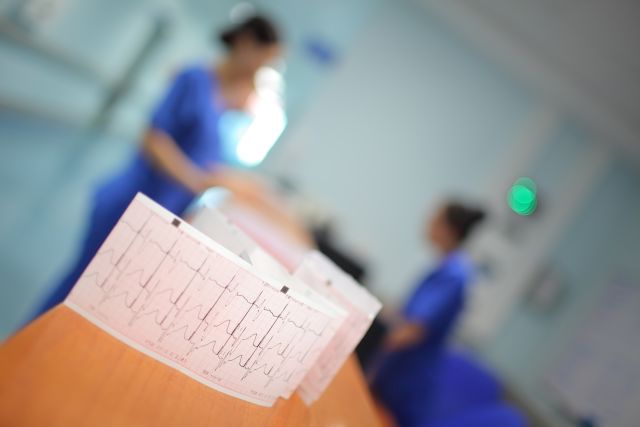Cardiac arrest occurs when your heart stops pumping suddenly. Unlike a heart attack, which occurs when the blood flow that supplies the heart with oxygen is blocked, cardiac arrest occurs when the heart’s electrical system malfunctions.
Some people may experience symptoms beforehand, such as chest pain, heart palpitations, shortness of breath and weakness—but sudden cardiac arrest may occur without warning. In all cases, however, this life-threatening emergency requires immediate medical treatment, according to Nelson A. Prager, MD, a cardiologist at The Medical Center of Aurora in Aurora, Colorado.
“Time is of the essence when this occurs,” cautions Dr. Prager, who specializes in electrophysiology and heart rhythm disorders. “Within minutes, your brain is deprived of blood.”
Cardiac arrest could happen for a variety of reasons, including a heart attack. But in many cases, arrhythmias are to blame. These disruptions to the electrical signals that coordinate your heart rhythm can cause it to race, slow down or become chaotic, which can affect blood flow, Prager explains.
Dangerous heart rhythms
The heart has four chambers. Two of them— the lower right and left ventricles—pump blood from your heart to the lungs and the rest of your body. Meanwhile, the other two—the upper right and left atria—receive blood back from the body.
Not all arrhythmias are life-threatening. But atrial arrhythmias that start in the heart’s upper champers, such as atrial fibrillation (AFib), may increase the risk for cardiac arrest. The most serious abnormal heart rhythm more often linked with these life-threatening events however, is ventricular fibrillation, or VFib.
VFib occurs when the heart’s lower chambers start to quiver rather than beat normally, which stops blood flow. This could trigger cardiac arrest.
Another arrhythmia which may, in certain cases, be linked to cardiac arrest is called ventricular tachycardia (VT) or V-tach. This involves abnormal electrical signals in the heart’s lower chambers that result in an abnormally fast heart rhythm, which prevents the heart from filling up with blood between beats.
The severity of V-tach and the presence of underlying heart disease plays a role in whether or not this type of arrhythmia may be very serious or life-threatening. If V-tach persists for more than 30 seconds, it can trigger palpitations, dizziness or fainting. If left untreated, V-tach often leads to VFib.
Less often, the heart may stop beating due to bradycardia, which is an abnormally slow heart rhythm. If your heart rate is too slow, your brain may be deprived of oxygen-rich blood. In extreme cases, this could lead to cardiac arrest.
Are you at risk?
More than 350,000 deaths caused by sudden cardiac arrest occur outside of a hospital setting in the U.S. every year. Incidence increases with age, and men are more likely to be affected than women.
Those with heart disease are also at a much higher risk. High blood pressure, high cholesterol, diabetes, smoking and obesity are all major risk factors for heart disease, which increases the risk for cardiac arrest, Prager points out.
“Heart disease or a blocked artery can cause instability of the heart’s electrical activity,” he explains. In fact, 75 percent of sudden cardiac deaths occur in people who have had a heart attack—usually within six months.
Meanwhile, those with heart failure—their heart isn’t pumping as well as it should—may be up to nine times more likely to experience ventricular arrhythmias that can lead to sudden cardiac arrest. People with potassium or magnesium imbalances may also be at higher risk for VFib.
Other cardiac arrest risk factors include having a personal or family history of arrhythmias or inherited diseases associated with abnormal heart rhythms, including Wolff-Parkinson-White syndrome and Long QT syndrome. These conditions are usually the cause of sudden cardiac arrest in children, which is worrisome but rare.
Responding to cardiac arrest
Cardiac arrest is an emergency that requires immediate medical attention. This is one of the reasons that automatic external defibrillators (AEDs) are becoming increasingly commonplace in public spaces, Prager says. “The hope is that if someone goes into cardiac arrest, we can shock them out of it,” he explains.
If you come upon someone who’s unresponsive, “Check for a pulse first,” says Prager. “If there is no pulse and the person is not breathing, start cardiopulmonary resuscitation (CPR) right away and call 911 for help.”
CPR or compression-only CPR keeps blood circulating. If there is an AED, use it, Prager advises. “Automatic external defibrillators send an electric shock to the heart to try to restore its normal rhythm,” he says. “They are fairly intuitive to operate and can be used by non-medical personnel.”
Following cardiac arrest, survivors will likely be admitted to the hospital to determine what caused their heart to stop beating. It’s important to treat underlying heart disease or an arrhythmia and restore the heart’s normal rhythms in order to prevent future events.
Managing risk long-term
“If you have a family history of arrhythmias or inherited diseases associated with abnormal heart rhythms, your doctor may want to do a full workup,” Prager points out.
Those at high risk for cardiac arrest due to a personal or family history of heart rhythm disorders may need treatment. Those with an arrhythmia may benefit from one or more of the following:
- Anti-arrhythmic medications: Certain drugs may be used to help maintain a steady heartbeat.
- An implantable cardioverter defibrillator (ICD) or pacemaker: These devices are usually used to manage a slow heart rate but some ICDs also function as pacemakers. They are placed under the collar bone to help keep the heart beating normally. “It is important to see your doctor every three months to make sure the device is working correctly,” Prager notes. “They need to be replaced every five to seven years.”
- Cardiac ablation: This is a procedure that uses heat (radiofrequency energy) or extreme cold (cryoablation) to destroy a small area of heart tissue that is causing rapid and irregular heartbeats.
- Electrical cardioversion: This procedure uses an electric current to restore a normal heart rhythm.
Those with underlying heart disease may need one of the following:
- Coronary angioplasty: This minimally invasive procedure is used to widen blocked or narrowed coronary arteries.
- Surgery, such as coronary bypass: An operation can manage blocked heart arteries by redirecting blood to the heart, using arteries or veins from other parts of the body.
Making heart-healthy lifestyle changes can also help prevent sudden cardiac arrest. This includes maintaining a healthy weight, getting regular physical activity, not smoking, keeping your blood pressure and cholesterol levels under control and following a healthy diet that emphasizes a range of fruits and vegetables, whole grains and lean protein while limiting sugar, saturated fat and salt.







